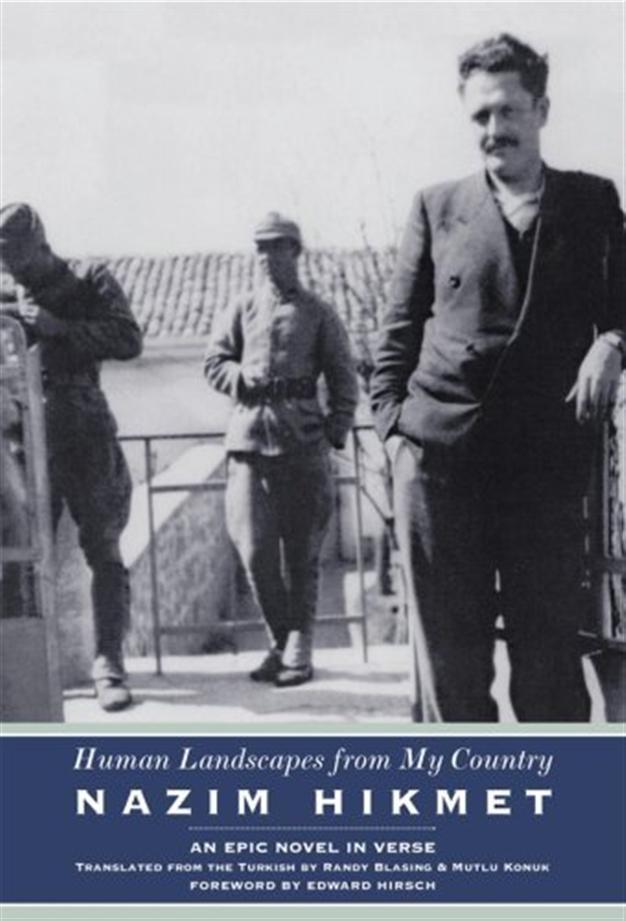'Human Landscapes from My Country' by Nazım Hikmet
William Armstrong - william.armstrong@hdn.com.tr
 ‘Human Landscapes from My Country’ by Nazım Hikmet, translated by Randy Blasing & Mutlu Konuk
‘Human Landscapes from My Country’ by Nazım Hikmet, translated by Randy Blasing & Mutlu Konuk
(Persea Books, 2009, $20, pp 466)
During Nazım Hikmet’s long stay in jail from 1938 to 1950, he not only composed the whole of his epic poem “Human Landscapes from My Country,” but also translated Leo Tolstoy’s “War and Peace” into Turkish. That he chose to translate Tolstoy’s great work is perhaps surprising - although Hikmet respected the “grand old man,” his own work reflected very different assumptions about human agency. While Tolstoy’s epic is shaped by his understanding of man’s essential helplessness in the face of the turning wheel of history, such a vision is anathema to Hikmet. Like all of his work, “Human Landscapes…” is shot through with the optimistic conviction that human beings have the capacity to forge their own path upwards by sheer force of their own will. More than the Achilles heel of his communism, it is perhaps this generosity of spirit that forms the guiding philosophy across his oeuvre. As a student in the poem reflects at one point, “giving up hope in humanity” is little more than “after-dinner philosophizing.”
The first two books of the poem follow parallel rail journeys heading into Anatolia from Istanbul’s Haydarpaşa Station in 1941, the trains becoming symbolic microcosms of Turkey’s “human landscape.” Book three is set in a prison in the middle of the Anatolian steppe, while books four and five are more experimental, casting the net out even further and cutting between scenes across time and space. All are portrayed through the eyes of the various characters – from the top to the bottom of the social spectrum - but expressed through Hikmet’s own inimitably direct poetic style. As a pasha’s grandson and an Istanbul intellectual, he had no real sustained contact with ordinary Anatolian peasants, but in jail he was able to marinade himself in the “true” peasant vernacular. “Human Landscapes…” is therefore filled with real life models from Bursa Prison, which is probably why they are drawn with such vividness.
In the poem, Hikmet takes the traditional oral epic form and adapts it to the modern condition by using elements of drama, film and the novel. This makes it a doubly difficult task for the translator to be alive to every subtle contour, and Mutlu Konak, who recently wrote an excellent biography of Hikmet, does a miraculous job here. In her introduction, she suggests that Hikmet chose to write it as poetry “not for self-protection or to distance himself from his material,” but rather because “poetry was more economical: it could say so much more so much faster than prose.” This becomes clear on reading; “Human Landscapes” spreads across 17,000 iron-forged lines, but it is extraordinarily efficient, never wasting a single word.
The whole thing effectively amounts to a compendium of Anatolia’s collective memories, traumas, hopes and fears at the time of the Second World War. At one point towards the beginning of the first train journey, the narrative looks back in the direction from which it has come:
The train rounds a bend.
The rest of the cars appear
one by one,
all tied to one another
far into the distance
It comes as a surprise
to be tied to things so far back.
It’s a key passage, with a poignancy that Hikmet was surely aware of. The “romantic communist” believed ardently that men could shape and improve their own destiny, but he was also temperamentally allergic to the constraints of rigid ideology. For all his unswerving loyalty to the idea of forging ahead into the bright future, he knew that, as Marx himself wrote, “the dead generations weigh like a nightmare on the brains of the living.”
Notable recent release
‘Reflections on Turkey: The Turkish-American-Israeli Relations and the Middle East’ by Mehmet Kalyoncu
(Blue Dome Press, £13.50, pp 352)
William Armstrong,
 ‘Human Landscapes from My Country’ by Nazım Hikmet, translated by Randy Blasing & Mutlu Konuk
‘Human Landscapes from My Country’ by Nazım Hikmet, translated by Randy Blasing & Mutlu Konuk